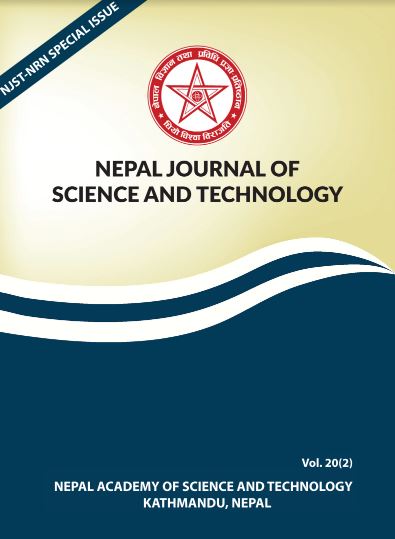First-Principles Study of Defected Single Layer Hexagonal Boron-Nitride (h-BN)
DOI:
https://doi.org/10.3126/njst.v20i2.45775Keywords:
DFT, impurity, vacancy, defects, magnetic momentAbstract
The novel properties of pristine h-BN, oxygen (O) atom impurity defects in h-BN (h-B(N-O) and h-(B-O)N), one boron (1B) atom vacancy defect in h-BN (h-BN_1B) and one nitrogen (1N) atom vacancy defect in h-BN (h-BN_1N) materials are investigated by spin-polarized density functional theory (DFT) using computational tool Quantum ESPRESSO. We found that they are stable materials. From the band structure calculations, we found that all the considered systems are wide bandgap materials. The bandgap energy of pristine h-BN, impurity defects h-B(N-O) and h-(B-O)N, and vacancy defects h-BN_1B and h-BN_1Nmaterials have values 4.98 eV, 4.19 eV& 2.47 eV,and 4.84 eV& 3.62 eV respectively. Also, it is found that h-B(N-O) and h-BN_1N materials have n-type Schottky contact while h-(B-O)N and h-BN_1B materials have p-type Schottky contact. From the analysis ofdensity of states (DOS) and partial density of states (PDOS) calculations, we found that non-magnetic pristine h-BN changes to magnetic h-B(N-O) andh-(B-O)N materials due to presence of impurity defects,and h-BN_1B andh-BN_1N materials due to presence of vacancy defects. Magnetic moments of h-B(N-O), h-(B-O)N, h-BN_1B and h-BN_1N materials are 1.00 µB/cell, 0.94 µB/cell, 3.00 µB/cell and 1.00 µB/cell respectively. They are obtained due to unpaired up and down spins state of electrons in 2p orbital of B and N atoms in the structures.
Downloads
Downloads
Published
How to Cite
Issue
Section
License
Copyright (c) 2021 Hari Krishna Neupane, Narayan Prasad Adhikari

This work is licensed under a Creative Commons Attribution-NonCommercial 4.0 International License.
Authors retain copyright and grant the journal right of first publication.




